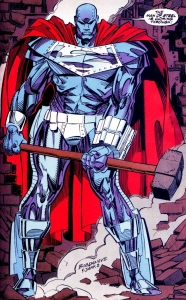
After playing a large role in the story arc that ushered Superman back into the land of the living, Steel was given his own title with co-creator Louise "Weezie" Simonson at the helm as writer in 1994. Simonson moved Steel back to his hometown of Washington, DC, where he initially went toe-to-toe with his former employers at the defense contractor AmerTek who were funneling guns designed by Irons back in the day on to the streets and into the hands of gang members. The early days of the comic, which can be read on the cheap (4-ish dollars) in a used trade paperback off Amazon, were particularly refreshing because they featured an African American superhero taking on a real world evil (i.e., the military-industrial complex). These early days of the comic went on to be the source material for a fun, if poorly performing and ill conceived 1997 movie starring Shaquille O'Neil.
Once the corporate facade of AmerTek was brought to justice the remainder of Simonson's 33 issues of Steel suffered from some degree of obscuritiy. The real culprits of the series were revealed to be an ever more obscure and hard to believe cabal of secret international criminals with names like Hazard and White Rabbit whose presence was often revealed during hard to follow crossovers with other titles--even with other publishers. However, what Weezie was always able to accomplish steadfastly was to provide a fun lower tier of villains that DC Comics has not been using for a shameful 10 plus years. This included:

a ridiculously silly-looking man in yellow zoot suit who could increase his to tremendous proportions,

a high tech Navajo mercenary with a heart of gold, and my personal favorite

a four-armed, extraterrestial, cyborg space cowboy.
I DEMAND TO KNOW WHY DC COMICS HAS NOT BEEN USING THESE CHARACTERS FOR THE PAST 10+ YEARS. THEY ARE INSANELY PRICELESS.
When Christopher Priest took over on issue #34 picked a gritty "Dark Age" of comics feel to it and Steel, now stripped of his secret identity, was moved to Jersey City with his 16 year old niece who was under his protection. The series took some interesting turns, but the quality of the zany villains suffered dramatically. However, he did come up with a cool dude named Skorpio.

Like the Navajo Chindi, Skorpio was also a hired gun. He became a supervillain in order to pay of his tremendous amount of student debt. In a convoluted plot twist, Skorpio and Steel were both in the employ of the director the Jersey City hospital. What was really exciting was Skorpio's obsession with Steel's love interest. He had the tendency to call her on the telephone and make statements like this:

No comments:
Post a Comment